#502nd Parachute Infantry Regiment
Text

"Full victory - nothing else"
Le Général Eisenhower en discussion avec le Lieutenant Wallace C. Strobel du 502nd PIR de la 101st Airborne Division avant le décollage pour la Normandie – Opération Albany – Opération Overlord – base aérienne de la RAF de Greenham common – Angleterre – 20 h 30 – 5 juin 1944
©Library of Congress – LC-USZ62-25600
La photo montre le général Eisenhower discutant avec des parachutistes de la Compagnie E (easy Company) du 502e Régiment d'infanterie parachutiste de la 101e Division aéroportée sur la base aérienne de la RAF de Greenham Common.
Les personnages identifiés sont les suivants :
Le Sergent Fred Lindsey tenant un carnet de croquis, derrière et à gauche du dos d'Eisenhower (Source : Chad Lindsey, 2014)
Russell Wilmarth, derrière le menton d'Eisenhower (Source : Alan Offen, 2009)
Le lieutenant Wallace C. Strobel avec une étiquette '23' (Source : Dwight David Eisenhower - The Centennial, CMH Pub 71-40)
Ralph 'Bud' Thomas ou Arthur L. Wegener, à gauche de Strobel (Source : Eileen Thomas Hayes, 2012 et Sandra Edwards, 2021)
Probablement le caporal Donald E. Kruger, au premier rang, à l'extrême droite, portant un sac musette sur la poitrine (Source : Alice Kruger Bruns et Jason Bezis, 2013)
Joseph Burdette May Jr. (1920-1995), au-dessus du pouce d'Eisenhower (Source : Ashley Barnes, 2018)
#WWII#opération overlord#overlord#opérations aéroportées#airborne operations#opération albany#mission albany#parachutistes#paratroopers#101e division aéroportée#101st airborne division#502e régiment d'infanterie parachutiste#502nd parachute infantry regiment#502e PIR#502nd PIR#easy company#base aérienne de greenham common#raf greenham common#angleterre#england#05/06/1944#06/1944#1944#d-day
12 notes
·
View notes
Photo
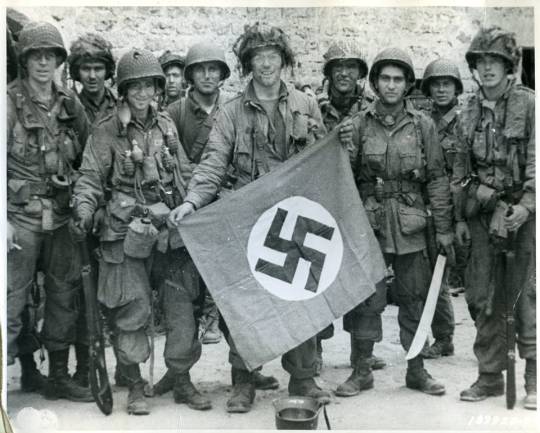
American paratrooper James Flanagan (2nd Platoon, C Co, 1-502nd Parachute Infantry Regiment, 101st Airborne Division) holds a Nazi flag captured in a village assault. Marmion Farm at Ravenoville, Utah Beach, Normandy, France. 8 June 1944
48 notes
·
View notes
Text
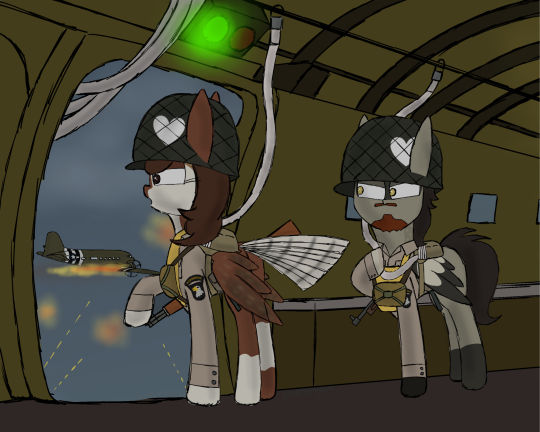
D-Day
June 6, 1944
0048
- DZ A -
"Stand up!"
" Hook up!"
"Equipment check!"
"Sound off equipment check!"
"Eighteen, okay!"
"Seventeen, okay!"
On and on it went until, "One, okay!"
Then they waited. The red light glowed in front of them. But as they waited the night sky suddenly came alive. Explosions suddenly errupted all around them, as streaks of tracer fire rose up into the sky. They could feel the C-47 sway as it tried to evade the anti-aircraft fire. Suddenly, the light turned green. In one swift movement, the line lurched forward, as one after another paratroopers leaped into the night sky.
----------------------------------------
The 502nd Parachute Infantry Regiment of the 101st Airborne was to drop into DZ A, behind Utah beach. The objective of the regiment was to capture the vital causeways that lead inland from Utah beach, as well as disable a German artillery battery near Saint-Martin-de-Varreville.
However, the drop was hampered by the fact that the pathfiners, who dropped in before the main force to deploy beacons to guide in the C-47s, were dropped in the wrong place. This, combined with anti-aircraft fire, resulted in the transport aircraft getting lost and scattered, which, in turn resulted in the paratroopers being dropped spreadout in the wrong areas. Out of the regiment's three battalions, only the 1st Battalion was able to land on the right place. In fact, they were the only unit, out of the whole 101st Airborne, that landed in the correct spot.
Despite the bad landings, the paratroopers of the 502nd managed to achieve their objectives, securing the causeways and securing Saint-Martin-de-Varreville. Their actions would help in the successful landing of the US 4th Infantry Division on Utah beach.
----------------------------------------
Featuring:
@temper-temper and @randomgurustuffs as paratroopers of the 502nd Parachute Infantry Regiment of the 101st Airborne Division, the "Screaming Eagles". Both have the heart insignia of the 502nd PIR on their helmets, which helped scattered paratroopers indicate the units of the troopers next to them.
#temper-temper#randomgurustuffs#Pegasus#Pegasi#MLP#My Little Pony#History#D-Day#Normandy#Normandy Landings#Operation Overlord#World War 2#WW2#June 6#D-Day As It Happened
36 notes
·
View notes
Text
Screaming Eagles (1956)

Basic Story: 1st Platoon, D Company, 502nd Parachute Infantry Regiment drops into Normandy with tension in the ranks, twenty miles from their drop zone.
Fan Thoughts: The 502nd is now familiar territory for series and movies, done with varying degrees of execution. Unfortunately this was one of those best skipped there are just too many unbelievable things that happen throughout. After establishing that Private Mason (Tom Tryon) is firmly the black sheep of the outfit, a newcomer with a chip on his shoulder, the men of D Company are dropped into Normandy. They land nearly twenty miles away from where they are supposed to and most make their way to the bridge they are supposed to take. They split into scouting parties and Mason’s group comes across a German sentry who takes aim at Corporal Dreef (Paul Burke) who Mason has already fought with; Mason throws a knife at the sentry and kills him but the sentry shoots Dreef as he falls. The other men accuse Mason of getting Dreef killed and he is relegated to helping guide Lieutenant Pauling (Jan Merlin) after he is blinded by enemy fire. The remaining men move on to a farmhouse where they take prisoner a German soldier and meet a French woman, Marianne (Jacqueline Beer), who happens to speak German. They force the soldier to give them information and radio false orders to the surrounding German army. Not only is this unbelievable since they have literally dragged him along for the ride, but he unsurprisingly betrays them immediately by leaving the radio on so the other radio operators can hear the Americans talking. The story continues implausibly along from there, ending when they finally arrive at the bridge they were supposed to hold where the rest of their company is. The selling point of this film is that many of the actors went on to have prominent careers in film and television, but there are plenty of other World War II films from the same era that have better and more believable writing.
Warnings: none
Available On: Prime Video, HBO Max
6 notes
·
View notes
Text
Brothers in arms earned in blood fixed exe

Today however, the mantra is aimed at a bunch of pot-bellied, dishevelled journalists, and bellowed by John Antal, recently retired US colonel and military adviser on Gearbox's mouth-moistening WWII shooter Brothers In Arms.įor the past three and a half years, Gearbox has been feverishly researchin the role that the 502nd regiment played during the Allies' Normandy invasion in World War II. It's the kind of rallying cry that helped fortify the spirits of the brave men of the 502nd Parachute Infantry Regiment minutes before they dropped into Normandy in a daring and massively successful bid to flank the German defenders during the D-Day landings. Gearbox isn't talking about what it's got powering it yet either, but we do know of another engine that has similarly jawdropping facial animation. But our money is currently on the untamed action of Brothers In Arms and the pedigree of Gearbox, who developed the supreme Half-Life expansion pack Opposing Force and, most recently. Here, the metal beasts are as they truly were: killing machines that'll be a terrifying proposition to take down.Ī storm is currently brewing in the realms of the squad-based shooter, with Close Combat: First to Fight, SWAT 4, Ghost Recon 2 and Conflict: Vietnam all vying for the top spot. There's no Call Of Duty-style Panzerfaust-lugging solo heroics either -you won't be destroying four tanks per level. Even the hand signals you frantically wave at your petrified troops are direct from the fields of WWII combat. Death By TankĮven historical events - such as a paratrooper getting tangled in a tree directly above a German mobile kitchen and being used as target practice - are directly recreated. When you stand at Dead Man's Comer (so-called after the German officer who, in reality and in the game, was draped over a wrecked tank on a major Allied transport route) and gaze out over the burning town of Cotes D'Armor, then that's the exact same view soldiers would have seen back in 1944. Every townhouse, out-house and henhouse has been lovingly recreated from veterans' memories, contemporary photos, aerial photography and developer visits to the battlefield. The Real ThingĪnd 'authentic' is the key word here. You can choose any path for your tactical cleverness, whether it's through a field, around a farmhouse or leaping over the authentic Normandy ditches. And you can take any route you want - this isn't a run-of-the-mill corridor blaster. If you were to come across a German machine-gun emplacement, for instance, it's your role to order your men, with one deft click of the mouse, to deliver some suppressive fire and pin them down while you and your light-footed squad members find a way to get a better shot. Your squad, who you gather together as the game progresses, are separated into two groups - one with heavy guns that can suppress German outfits, and the other with lighter armaments and grenades, who you can use to flank, sneak and outmanoeuvre the enemy. Their faces are so life-like, it's honestly disconcerting the first time you see it. What first strikes you when you see Brothers In Arms is the astonishing detail in your fellow paratroopers - the way their eyeballs follow your movement, their sneers and snarls, the looks of fear and pain. You've been dropped behind enemy lines, separated from your scattered men, and are instrumental to the success of the Allied incursion into Normandy. Played out in real-time between June 8 and 13,1944 (well, real-time without the boring bits), Brothers In Arms puts you in the army-issue boots of squad leader Sgt Matt Baker.

0 notes
Photo
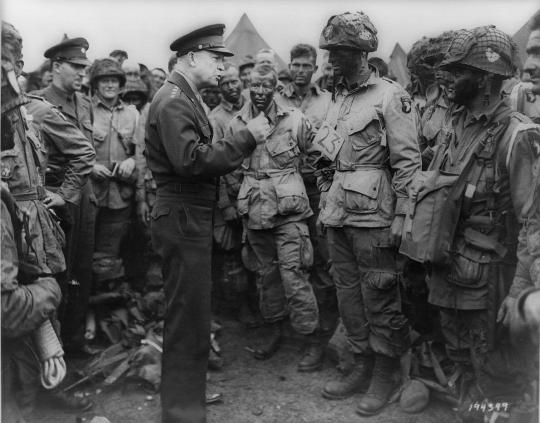
Eisenhower speaks with men of the 502nd Parachute Infantry Regiment, part of the 101st Airborne Division, on June 5, 1944, the day before the D-Day invasion. [1189x931] Check this blog!
16 notes
·
View notes
Text
3 notes
·
View notes
Photo
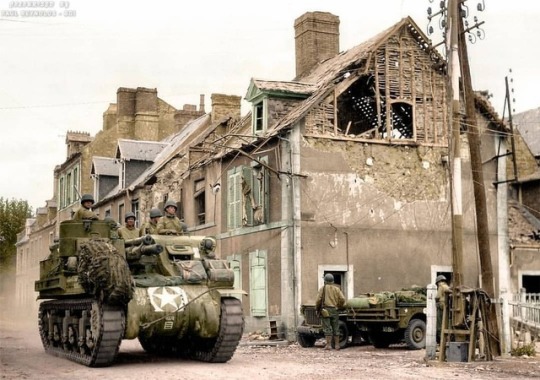
A 105 mm Howitzer Motor Carriage M7B1 'Priest' of the 14th Armored Field Battalion, 2nd Armored Division moves down Rue Holgate, Carentan, Normandy on the 18th June 1944. The nickname 'Priest' was given to the vehicle by the British due to the machine-gun ring looking like a pulpit. At dawn on 13 June, the 101st Airborne was about to attack the German line when it was attacked by tanks and assault guns. Two battalions of Panzergrenadier-Regiment 37, supported by elements of the 17.SS-Panzergrenadier-Division "Götz von Berlichingen" and III./Fallschirmjäger-Regiment 6, struck hard at the 501st Parachute Infantry Regiment on the American left, which fell back under heavy pressure. The left flank companies (Dog and Fox Companies) of the 506th then gave way, and by noon the spearheads of the German attack were within 500 yards of Carentan. However, Company E (Easy) of the 506th, commanded by 1st Lt. Richard D. Winters, anchored its right flank against a railroad embankment and held its position. Reinforced by the 2nd battalion, 502nd Parachute Infantry Regiment taking position on its right, Easy Company slowed the German attack until American tanks could be brought up. Reacting to an Ultra warning of the size and threat of the counterattack, Lieutenant General Bradley diverted Combat Command A of the U.S. 2nd Armored Division (commanded by Brig. Gen. Maurice Rose and near Isigny sur mer) to Carentan at 10:30. At 14:00 Combat Command A attacked, supported by the self-propelled howitzers of the 14th Armored Field Artillery Battalion. One task force of tanks and mechanized infantry surged down the road to Baupte in the 2nd Battalion of the 506th's area and shattered the main German thrust. A second task force drove back German forces along the Périers highway, inflicting heavy losses in men and equipment. Combat Command A, followed by the 502nd Parachute Infantry Regiment, then pushed west a mile beyond the original lines. The counterattack became known anecdotally among the surviving paratroopers as the "Battle of Bloody Gulch". Colorized by: Paul Reynolds. https://www.instagram.com/p/Bw64wRlHND6/?igshid=v6hus51k7syi
15 notes
·
View notes
Photo

Eisenhower speaks with U.S. Army paratroopers before D-Day invasion deployment, June 5, 1944, Greenham Common Airfield,England
"It would be difficult to conceive of a more soul-racking problem." - Gen. Dwight D. Eisenhower
It had been determined that the success of the June 6, 1944, Allied Normandy Landing, "might well turn on the success of the paratroopers behind the lines."
Four days before the invasion, it was estimated that the 75% of the paratroopers might be killed or wounded before reaching the ground. But if the paratroopers did not seize and secure the causeways, the landing on the beach would have little success. After a great deal of soul searching, Eisenhower sent in the paratroopers.
On June 5, Eisenhower went to the Greenham Common Airfield, England to see the men off. In this iconic photo, Eisenhower is seen talking to Lt. Wallace C. Strobel. Strobel is wearing the number 23 around his neck. The number signified that he was the jumpmaster of plane number 23 in the 502nd Parachute Infantry Regiment, 101st Airborne Division. Strobel and a second man can be seen wearing a live Hawkins Mine (used to blow the tread off a tank) strapped to their leg.
Eisenhower and Strobel talked about fishing in Strobel’s home state of Michigan.
"Eisenhower told Capt. L. 'Legs' Johnson, 'I've done all I can, now it is up to you.' He told a group of enlisted men not to worry, that they had the best equipment and leaders in the world, with a vast force coming in behind them. A sergeant from Texas piped up, 'Hell, we ain't worried, General. It's the Krauts that ought to be worrying now.'"
Eisenhower had gone to see the boys off to boost their morale. Stobel would later note, “I honestly think it was his morale that was improved by being with us."
“A Red Cross worker was at the airfield passing out doughnuts and hot coffee to the paratroopers that night when Ike drove up. She gave him a cup of coffee, too. But, then, she noticed his hand was shaking so badly the coffee threatened to spill over -- could burn him -- and eased the cup out of his hand.”
Eisenhower would later recount, "The airborne boys did their job. …. And, I am happy to say, the casualties were only 8%."
#geneisenhower#wallacestrobel#battleofnormandy#AlliedNormandyLanding#worldwar2#dday#dday75#wwII#WWII photo#ww2 color photo#historyinfullcolor#historyincolor#ww2gen#101stairbornedivision#502ndParachuteInfantryRegiment#paratroopers
3 notes
·
View notes
Text
Story of Iron Mike
“He’ll either be a general or a dead colonel,” – cracked G.I.s about commander, “Iron Mike.”“Iron Mike” General John Hersey Michaelis.Photo restored By Johnny SirlandeAs a Lieutenant Colonel in World War II, he was Executive Officer of the 502nd Parachute Infantry Regiment of the 101st Airborne Division, but took command of the unit on 9 June 1944 after the commanding officer, Colonel George Van…

View On WordPress
0 notes
Photo
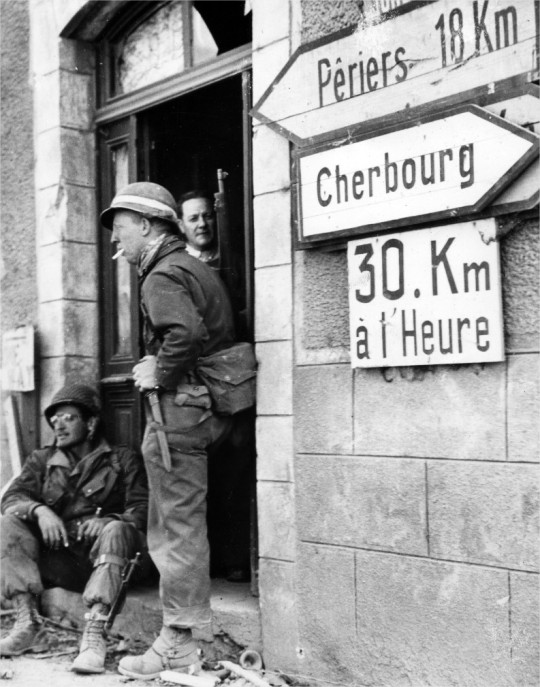
Parachutistes du 502e Régiment d'infanterie parachutiste de la 101e Division aéroportée US (les Screaming Eagles) au repos devant la porte d'entrée du café-restaurant Désiré Ingouf - Bataille de Carentan – Bataille de Normandie – Carentan – 12 juin 1944
Le café-restaurant Désiré Ingouf est un établissement que l'on aperçoit dans l'épisode «Carentan» de la série Band of Brothers.
Qui est cet homme en arrière-plan dans l’encadrement de la porte ? Désiré Ingouf ?
#WWII#opération overlord#overlord#Bataille de Normandie#battle of normandy#Bataille de Carentan#battle of carentan#armée américaine#american army#US Army#Troupes aéroportées#parachutistes#paratroopers#101e Division aéroportée US#101st airborne division#screaming eagles#502e Régiment d'infanterie parachutiste#502nd Parachute Infantry Regiment#Café Désiré Ingouf#Band of Brothers#Carentan#manche#normandie#normandy#France#12/06/1944#06/1944#1944
21 notes
·
View notes
Photo

Eisenhower speaks with men of the 502nd Parachute Infantry Regiment, part of the 101st Airborne Division, on June 5, 1944, the day before the D-Day invasion. [1189x931] via /r/HistoryPorn https://ift.tt/2HaCLPM
0 notes
Photo

Preparing for the Jump _ General Dwight D. Eisenhower talking with 1st Lieutenant Wallace C. Strobel (23) and some of the paratroopers from E Company, 2nd Battalion, 502nd Parachute Infantry Regiment, of the 101st Airborne Division, just before they board their Douglas C-47 Skytrains in route to Normandy, France, on June 5th 1944, at Greenham Common Airfield in England. _ Lieutenant Colonel George Van Horn Mosley Jr. was the 39 year old commander of the 502nd Parachute Infantry Regiment leading up to and during D-Day. During the jump Mosley was injured and refused to be evacuated. He maintained command of the 502nd for two days from a wheelbarrow, until being evacuated back to England. https://www.instagram.com/p/B5JPyCkAvpR/?igshid=393azvs1h7x2
0 notes
Photo

Picture Of The Day http://bit.ly/2Ws0J39
Allied forces Supreme Commander General Dwight D. Eisenhower speaks with U.S. Army paratroopers of Easy Company, 502nd Parachute Infantry Regiment (Strike) of the 101st Airborne Division, at Greenham Common Airfield in England June 5, 1944. REUTERS/U.S. National Archives/Handout via Reuters
WNU Editor: The above picture is from this photo-gallery .... D-Day: The Allied invasion of Normandy (Reuters).
from War News Updates http://bit.ly/2MvMeXC
via IFTTT
0 notes
Photo

Rare Original WW 2 US Army 502nd Parachute Infantry Regiment Patch Inv# X042
BUY IT NOW – Rare Original WW 2 US Army 502nd Parachute Infantry Regiment Patch Inv# X042
0 notes
Text

🇺🇲 WWII uncovered: Memorial Day 2021: Lt Col Robert Cole: 101st Airborne: Hero of the Battle of Carentan
Lieutenant Colonel Robert George Cole, of Fort Sam Houston Texas, parachuted into Normandy with the 3rd Battalion of the 502nd Parachute Infantry Regiment, 101st Airborne Division on June 6, 1944.
According to the National Medal of Honor Museum, "The task of securing Carentan was assigned to Lieutenant Colonel Robert Cole. After determining that there were no other viable approach paths, Cole realized that the Carentan Causeway (Highway N-13) – a raised and exposed road surrounded by flooded marshland – was the only way to reach the town. Even worse the men of the 3rd battalion would need to cross over 4 narrow bridges – one of which had been dropped into the Douve River by the Germans – all while being within easy range of German snipers, machine guns, and artillery."
"Late on the afternoon of June 10, Cole ordered elements of his command down the causeway towards the objective. As his men made their way over Bridge Two and through a narrow iron gate at Bridge Four, the men came under small arms fire from the town. With the advance at a standstill, Cole moved down the causeway shouting at them to get up and return fire on the enemy. Company I, which started the day with 85 men was down to 23 effectives. An attack by a German Stuka dive bomber only made things worse. During the evening, Cole surveyed the situation. To stay in the current location would leave his men exposed. To retreat would be just as bad. Cole realized that his best option was to order a frontal attack at dawn on the German positions just off the causeway to his front. Cole’s men, with the help of American artillery, were able to hold back two determined counterattacks by the Germans. The 506th Parachute Infantry Regiment crossed the bridges that night to relieve Cole’s worn out unit. That regiment, along with the 327th Glider Infantry Regiment, would take the town the next morning. Thanks to Cole’s attack and his battalion’s sacrifice, the strategic town of Carentan was in American hands. Cole’s men had paid a terrible price for their bravery. Of the 700 men in the 3rd Battalion, just 132 of the “Screaming Eagles” were left standing. (Source: National Medal of Honor Museum)
⭐Lt Colonel Cole's Medal of Honor Citation reads as follows:
For gallantry and intrepidity at the risk of his own life, above and beyond the call of duty on 11 June 1944, in France. Lt. Col. Cole was personally leading his battalion in forcing the last 4 bridges on the road to Carentan when his entire unit was suddenly pinned to the ground by intense and withering enemy rifle, machinegun, mortar, and artillery fire placed upon them from well-prepared and heavily fortified positions within 150 yards of the foremost elements. After the devastating and unceasing enemy fire had for over 1 hour prevented any move and inflicted numerous casualties, Lt. Col. Cole, observing this almost hopeless situation, courageously issued orders to assault the enemy positions with fixed bayonets. With utter disregard for his own safety and completely ignoring the enemy fire, he rose to his feet in front of his battalion and with drawn pistol shouted to his men to follow him in the assault. Catching up a fallen man’s rifle and bayonet, he charged on and led the remnants of his battalion across the bullet-swept open ground and into the enemy position. His heroic and valiant action in so inspiring his men resulted in the complete establishment of our bridgehead across the Douve River. The cool fearlessness, personal bravery, and outstanding leadership displayed by Lieutenant Colonel Cole reflect great credit upon himself and are worthy of the highest praise in the military service.
On September 18, 1944, Robert Cole was killed by a German sniper near the town of Best during Operation Market Garden. Cole’s widow and two-year old son accepted the Medal of Honor at a ceremony at Fort Sam Houston. Robert was only 29 years old at the time of his death. Lt Col Cole lies in rest at the Netherlands American Cemetery and Memorial in Margraten. Lest We Forget.
#ww2uncovered #MemorialDay2021 #ww2 #MedalOfHonor #greatestgeneration #WWII #WorldWarII #101stairborne #MemorialDay #screamingeagle #lestweforget
🎨Colorization compliments of Johnny Sirlande of Historic Photo Restored in Color.©️ To view more of his work visit: https://www.facebook.com/hprcolor
Original description sourced by The National Medal of Honor Museum, US National Archives and Photo sourced by Johnny Sirlande used with permission of the artist.
1 note
·
View note